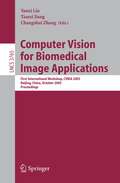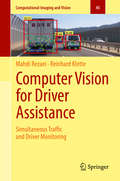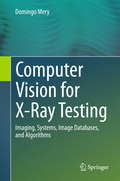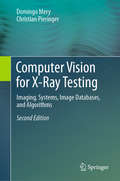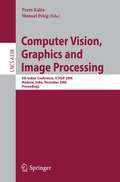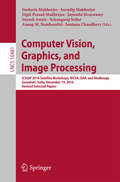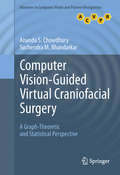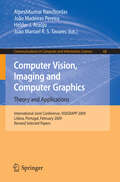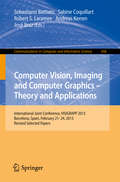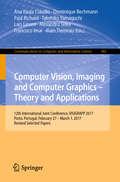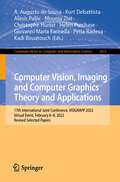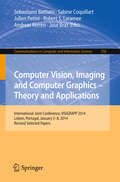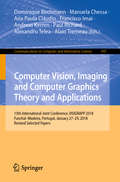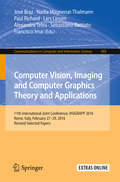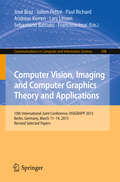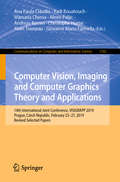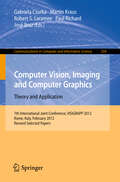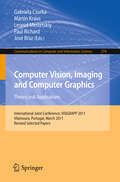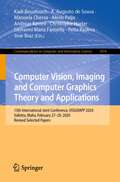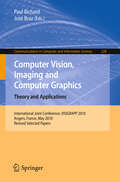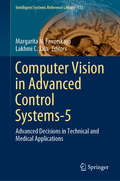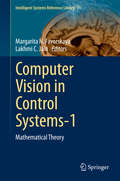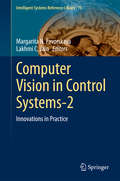- Table View
- List View
Computer Vision for Biomedical Image Applications: First International Workshop, CVBIA 2005, Beijing, China, October 21, 2005, Proceedings (Lecture Notes in Computer Science #3765)
by Yanxi Liu Tianzi Jiang Changshui ZhangWith the rapid increase in the variety and quantity of biomedical images in recent years, we see a steadily growing number of computer vision technologies applied to biomedical applications. The time is ripe for us to take a closer look at the accomplishments and experiences gained in this research subdomain, and to strategically plan the directions of our future research. The scientific goal of our workshop, “Computer Vision for Biomedical Image Applications: Current Techniques and Future Trends” (CVBIA), is to examine the diverse applications of computer vision to biomedical image applications, considering both current methods and promising new trends. An additional goal is to provide the opportunity for direct interactions between (1) prominent senior researchers and young scientists, including students, postdoctoral associates and junior faculty; (2) local researchers and international leaders in biomedical image analysis; and (3) computer scientists and medical practitioners. Our CVBIA workshop had two novel characteristics: each contributed paper was authored primarily by a young scientist, and the workshop attracted an unusually large number of well-respected invited speakers (and their papers). We had the good fortune of having Dr. Ayache of INRIA, France to talk about “Computational Anatomy and Computational Physiology,” Prof. Grimson of MIT to discuss “Analyzing Anatomical Structures: Leveraging Multiple Sources of Knowledge,” Dr. Jiang of the Chinese Academy of Sciences to present their work on “Computational Neuroanatomy and Brain Connectivity,” Prof.
Computer Vision for Driver Assistance: Simultaneous Traffic and Driver Monitoring (Computational Imaging and Vision #45)
by Mahdi Rezaei Reinhard KletteThis book summarises the state of the art in computer vision-based driver and road monitoring, focussing on monocular vision technology in particular, with the aim to address challenges of driver assistance and autonomous driving systems.While the systems designed for the assistance of drivers of on-road vehicles are currently converging to the design of autonomous vehicles, the research presented here focuses on scenarios where a driver is still assumed to pay attention to the traffic while operating a partially automated vehicle. Proposing various computer vision algorithms, techniques and methodologies, the authors also provide a general review of computer vision technologies that are relevant for driver assistance and fully autonomous vehicles.Computer Vision for Driver Assistance is the first book of its kind and will appeal to undergraduate and graduate students, researchers, engineers and those generally interested in computer vision-related topics in modern vehicle design.
Computer Vision for Electronics Manufacturing (Advances in Computer Vision and Machine Intelligence)
by L.F PauDEFECT PROPORTION OF DETECTION INITIAL RATE DETECTION RATE INSPECTOR 3 COMPLEXITY OF TIMES PAN OF PERFORMING o~ ________________________ o~ ______________________ __ -;. INSPECTION TASK -;. VISUAL INSPECTION Fagure 1. Trends in relations between the complexity of inspection tasks, defect detection rates (absolute and relative), and inspection time. Irrespective of the necessities described above, and with the excep tion of specific generic application systems (e.g., bare-board PCB inspection, wafer inspection, solder joint inspection, linewidth measure ment), vision systems are still not found frequently in today's electronics factories. Besides cost, some major reasons for this absence are: 1. The detection robustness or accuracy is still insufficient. 2. The total inspection time is often too high, although this can frequently be attributed to mechanical handling or sensing. 3. There are persistent gaps among process engineers, CAD en gineers, manufacturing engineers, test specialists, and computer vision specialists, as problems dominate the day-to-day interac tions and prevent the establishment of trust. 4. Computer vision specialists sometimes still believe that their contributions are universal, so that adaptation to each real problem becomes tedious, or stumbles over the insufficient availabIlity of multidisciplinary expertise. Whether we like it or not, we must still use appropriate sensors, lighting, and combina tions of algorithms for each class of applications; likewise, we cannot design mechanical handling, illumination, and sensing in isolation from each other.
Computer Vision for the Web
by Foat AkhmadeevUnleash the power of the Computer Vision algorithms in JavaScript to develop vision-enabled web content About This Book • Explore the exciting world of image processing, and face and gesture recognition, and implement them in your website • Develop wonderful web projects to implement Computer Vision algorithms in an effective way • A fast-paced guide to help you deal with real-world Computer Vision applications using JavaScript libraries Who This Book Is For If you have an interest in Computer Vision or wish to apply Computer Vision algorithms such as face, custom object, and gesture recognition for an online application, then this book is ideal for you. Prior understanding of the JavaScript language and core mathematical concepts is recommended. What You Will Learn • Apply complex Computer Vision algorithms in your applications using JavaScript • Put together different JavaScript libraries to discover objects in photos • Get to grips with developing simple computer vision applications on your own • Understand when and why you should use different computer vision methods • Apply various image filters to images and videos • Recognize and track many different objects, including face and face particles using powerful face recognition algorithms • Explore ways to control your browser without touching the mouse or keyboard In Detail JavaScript is a dynamic and prototype-based programming language supported by every browser today. JavaScript libraries boast outstanding functionalities that enable you to furnish your own Computer Vision projects, making it easier to develop JavaScript–based applications, especially for web-centric technologies. It makes the implementation of Computer Vision algorithms easier as it supports scheme-based functional programming. This book will give you an insight into controlling your applications with gestures and head motion and readying them for the web. Packed with real-world tasks, it begins with a walkthrough of the basic concepts of Computer Vision that the JavaScript world offers us, and you'll implement various powerful algorithms in your own online application. Then, we move on to a comprehensive analysis of JavaScript functions and their applications. Furthermore, the book will show you how to implement filters and image segmentation, and use tracking.js and jsfeat libraries to convert your browser into Photoshop. Subjects such as object and custom detection, feature extraction, and object matching are covered to help you find an object in a photo. You will see how a complex object such as a face can be recognized by a browser as you move toward the end of the book. Finally, you will focus on algorithms to create a human interface. By the end of this book, you will be familiarized with the application of complex Computer Vision algorithms to develop your own applications, without spending much time learning sophisticated theory. Style and approach This book is an easy-to-follow project-based guide that throws you directly into the excitement of the Computer Vision theme. A “more in less” approach is followed by important concepts explained in a to-the-point, easy-to-understand manner.
Computer Vision for X-Ray Testing: Imaging, Systems, Image Databases, and Algorithms
by Domingo MeryThis accessible textbook presents an introduction to computer vision algorithms for industrially-relevant applications of X-ray testing. Features: introduces the mathematical background for monocular and multiple view geometry; describes the main techniques for image processing used in X-ray testing; presents a range of different representations for X-ray images, explaining how these enable new features to be extracted from the original image; examines a range of known X-ray image classifiers and classification strategies; discusses some basic concepts for the simulation of X-ray images and presents simple geometric and imaging models that can be used in the simulation; reviews a variety of applications for X-ray testing, from industrial inspection and baggage screening to the quality control of natural products; provides supporting material at an associated website, including a database of X-ray images and a Matlab toolbox for use with the book’s many examples.
Computer Vision for X-Ray Testing: Imaging, Systems, Image Databases, and Algorithms
by Domingo Mery Christian Pieringer[FIRST EDITION] This accessible textbook presents an introduction to computer vision algorithms for industrially-relevant applications of X-ray testing. Features: introduces the mathematical background for monocular and multiple view geometry; describes the main techniques for image processing used in X-ray testing; presents a range of different representations for X-ray images, explaining how these enable new features to be extracted from the original image; examines a range of known X-ray image classifiers and classification strategies; discusses some basic concepts for the simulation of X-ray images and presents simple geometric and imaging models that can be used in the simulation; reviews a variety of applications for X-ray testing, from industrial inspection and baggage screening to the quality control of natural products; provides supporting material at an associated website, including a database of X-ray images and a Matlab toolbox for use with the book’s many examples.
Computer Vision, Graphics and Image Processing: 5th Indian Conference, ICVGIP 2006, Madurai, India, December 13-16, 2006, Proceedings (Lecture Notes in Computer Science #4338)
by Prem Kalra Shmuel PelegThis book constitutes the refereed proceedings of the Indian Conference on Computer Vision, Graphics and Image Processing, ICVGIP 2006, held in Madurai, India, December 2006. Coverage in this volume includes image restoration and super-resolution, image filtering, visualization, tracking and surveillance, face-, gesture-, and object-recognition, compression, content based image retrieval, stereo/camera calibration, and biometrics.
Computer Vision, Graphics, and Image Processing: ICVGIP 2016 Satellite Workshops, WCVA, DAR, and MedImage, Guwahati, India, December 19, 2016 Revised Selected Papers (Lecture Notes in Computer Science #10481)
by Snehasis Mukherjee Suvadip Mukherjee Dipti Prasad Mukherjee Jayanthi Sivaswamy Suyash Awate Srirangaraj Setlur Anoop M. Namboodiri Santanu ChaudhuryThis book constitutes the refereed conference proceedings of the ICVGIP 2016 Satellite Workshops, WCVA, DAR, and MedImage, held in Guwahati, India, in December 2016. The papers presented are extended versions of the papers of three of the four workshops: Computer Vision Applications, Document Analysis and Recognition and Medical Image Processing. The Computer Vision Application track received 52 submissions and after a rigorous review process, 18 papers were presented. The focus is mainly on industrial applications of computer vision and related technologies. The Document Analysis and Recognition track received 10 submissions from which 7 papers were selected. The MedImage workshops focuses on problems in medical image computing and received 14 papers from which 9 were accepted for presentation in this book.
Computer Vision-Guided Virtual Craniofacial Surgery: A Graph-Theoretic and Statistical Perspective (Advances in Computer Vision and Pattern Recognition)
by Ananda S. Chowdhury Suchendra M. BhandarkarThis unique text/reference discusses in depth the two integral components of reconstructive surgery; fracture detection, and reconstruction from broken bone fragments. In addition to supporting its application-oriented viewpoint with detailed coverage of theoretical issues, the work incorporates useful algorithms and relevant concepts from both graph theory and statistics. Topics and features: presents practical solutions for virtual craniofacial reconstruction and computer-aided fracture detection; discusses issues of image registration, object reconstruction, combinatorial pattern matching, and detection of salient points and regions in an image; investigates the concepts of maximum-weight graph matching, maximum-cardinality minimum-weight matching for a bipartite graph, determination of minimum cut in a flow network, and construction of automorphs of a cycle graph; examines the techniques of Markov random fields, hierarchical Bayesian restoration, Gibbs sampling, and Bayesian inference.
Computer Vision, Imaging and Computer Graphics: International Joint Conference, VISIGRAPP 2009, Lisboa, Portugal, February 5-8, 2009. Revised Selected Papers (Communications in Computer and Information Science #68)
by Joao Madeiras Pereira Hélder J. Araújo Joao Tavares AlpeshKumar RanchordasThis book includes extended versions of the selected papers from VISIGRAPP 2009, the International Joint Conference on Computer Vision, Imaging and Computer Graphics Theory and Applications, which was held in Lisbon, Portugal, during February 5–8, 2009 and organized by the Institute for Systems and Technologies of Information, Control and Communication (INSTICC). VISIGRAPP comprises three component conferences, namely, the International Conference on Computer Vision Theory and Applications (VISAPP), the International Conference on Computer Graphics Theory and Applications (GRAPP), and the International Conference on Imaging Theory and Applications (IMAGAPP). VISIGRAPP received a total of 422 paper submissions from more than 50 co- tries. From these, and after a rigorous double-blind evaluation method, 72 papers were published as full papers. These figures show that this conference is now an - tablished venue for researchers in the broad fields of computer vision, computer graphics and image analysis. From the full papers, 25 were selected for inclusion in this book. The selection process was based on the scores assigned by the Program Committee reviewers as well as the Session Chairs. After selection, the papers were further revised and extended by the authors. Our gratitude goes to all contributors and referees, without whom this book would not have been possible.
Computer Vision, Imaging and Computer Graphics: International Joint Conference, VISIGRAPP 2013, Barcelona, Spain, February 21-24, 2013, Revised Selected Papers (Communications in Computer and Information Science #458)
by Sebastiano Battiato, Sabine Coquillart, Robert S. Laramee, Andreas Kerren and José BrazThis book constitutes the refereed proceedings of the 8th International Conference, VISIGRAPP 2013 consisting of the Joint Conferences on Computer Vision (VISAPP), the International Conference on Computer Graphics, GRAPP 2013, and the International Conference on Information Visualization IVAPP 2013, held in Barcelona, Spain, in February 2013. The 15 revised full papers presented were carefully reviewed and selected from 445 submissions. The papers are organized in topical sections on theory and applications in computer vision, image analysis, computer graphics, and information visualization.
Computer Vision, Imaging and Computer Graphics – Theory and Applications: 12th International Joint Conference, VISIGRAPP 2017, Porto, Portugal, February 27 – March 1, 2017, Revised Selected Papers (Communications in Computer and Information Science #983)
by Ana Paula Cláudio Dominique Bechmann Paul Richard Takehiko Yamaguchi Lars Linsen Alexandru Telea Francisco Imai Alain TremeauThis book constitutes thoroughly revised and selected papers from the 12th International Joint Conference on Computer Vision, Imaging and Computer Graphics Theory and Applications, VISIGRAPP 2017, held in Porto, Portugal, February 27 - March 1, 2017. The 18 thoroughly revised and extended papers presented in this volume were carefully reviewed and selected from 402 submissions. The papers contribute to the understanding of relevant trends of current research on image and video formation, preprocessing, analysis and understanding; motion, tracking and stereo vision; computer graphics and rendering; data visualization and interactive visual data analysis; agent-based human-robot interactions; and user experience.
Computer Vision, Imaging and Computer Graphics Theory and Applications: 17th International Joint Conference, VISIGRAPP 2022, Virtual Event, February 6–8, 2022, Revised Selected Papers (Communications in Computer and Information Science #1815)
by A. Augusto de Sousa Kurt Debattista Alexis Paljic Mounia Ziat Christophe Hurter Helen Purchase Giovanni Maria Farinella Petia Radeva Kadi BouatouchThis book constitutes the referred proceedings of the 17th International Joint Conference on Computer Vision, Imaging and Computer Graphics Theory and Applications, VISIGRAPP 2022, Virtual Event, February 6–8, 2022. The 15 full papers included in this book were carefully reviewed and selected from 392 submissions. The purpose of VISIGRAPP is to bring together researchers and practitioners interested in both theoretical advances and applications of computer vision, computer graphics and information visualization. VISIGRAPP is composed of four co-located conferences, each specialized in at least one of the aforementioned main knowledge areas, namely GRAPP, IVAPP, HUCAPP and VISAPP.
Computer Vision, Imaging and Computer Graphics - Theory and Applications: International Joint Conference, VISIGRAPP 2014, Lisbon, Portugal, January 5-8, 2014, Revised Selected Papers (Communications in Computer and Information Science #550)
by Sebastiano Battiato Sabine Coquillart Julien Pettré Robert S. Laramee Andreas Kerren José BrazThis book constitutes the refereed proceedings of the International Conference, VISIGRAPP 2014, consisting of the Joint Conferences on Computer Vision (VISAPP), the International Conference on Computer Graphics, GRAPP 2014 and the International Conference on Information Visualization, IVAPP 2014, held in Lisbon, Portugal, in January 2014. The 22 revised full papers presented were carefully reviewed and selected from 543 submissions. The papers are organized in topical sections on computer graphics theory and applications; information visualization – theory and applications; computer vision theory and applications.
Computer Vision, Imaging and Computer Graphics Theory and Applications: 13th International Joint Conference, VISIGRAPP 2018 Funchal–Madeira, Portugal, January 27–29, 2018, Revised Selected Papers (Communications in Computer and Information Science #997)
by Dominique Bechmann Manuela Chessa Ana Paula Cláudio Francisco Imai Andreas Kerren Paul Richard Alexandru Telea Alain TremeauThis book constitutes thoroughly revised and selected papers from the 13th International Joint Conference on Computer Vision, Imaging and Computer Graphics Theory and Applications, VISIGRAPP 2018, held in Funchal-Madeira, Portugal, in January 2018. The 18 thoroughly revised and extended papers presented in this volume were carefully reviewed and selected from 317 submissions. The papers contribute to the understanding of relevant trends of current research on computer graphics; human computer interaction; information visualization; computer vision.
Computer Vision, Imaging and Computer Graphics Theory and Applications: 11th International Joint Conference, VISIGRAPP 2016, Rome, Italy, February 27 – 29, 2016, Revised Selected Papers (Communications in Computer and Information Science #693)
by José Braz Nadia Magnenat-Thalmann Paul Richard Lars Linsen Alexandru Telea Sebastiano Battiato Francisco ImaiThis book constitutes thoroughly revised and selected papers from the 11th International Joint Conference on Computer Vision, Imaging and Computer Graphics Theory and Applications, VISIGRAPP 2016, held in Rome, Italy, in February 2016. VISIGRAPP comprises GRAPP, International Conference on Computer Graphics Theory and Applications; IVAPP, International Conference on Information Visualization Theory and Applications; and VISAPP, International Conference on Computer Vision Theory and Applications. The 28 thoroughly revised and extended papers presented in this volume were carefully reviewed and selected from 338 submissions. The book also contains one invited talk in full-paper length. The regular papers were organized in topical sections named: computer graphics theory and applications; information visualization theory and applications; and computer vision theory and applications.
Computer Vision, Imaging and Computer Graphics Theory and Applications: 10th International Joint Conference, VISIGRAPP 2015, Berlin, Germany, March 11-14, 2015, Revised Selected Papers (Communications in Computer and Information Science #598)
by José Braz Julien Pettré Paul Richard Andreas Kerren Lars Linsen Sebastiano Battiato Francisco ImaiThis book constitutes thoroughly revised and selected papers from the 10th International Joint Conference on Computer Vision, Imaging and Computer Graphics Theory and Applications, VISIGRAPP 2015, held in Berlin, Germany, in March 2015. VISIGRAPP comprises GRAPP, International Conference on Computer Graphics Theory and Applications; IVAPP, International Conference on Information Visualization Theory and Applications; and VISAPP, International Conference on Computer Vision Theory and Applications. The 23 thoroughly revised and extended papers presented in this volume were carefully reviewed and selected from 529 submissions. The book also contains one invited talk in full-paper length. The regular papers were organized in topical sections named: computer graphics theory and applications; information visualization theory and applications; and computer vision theory and applications.
Computer Vision, Imaging and Computer Graphics Theory and Applications: 14th International Joint Conference, VISIGRAPP 2019, Prague, Czech Republic, February 25–27, 2019, Revised Selected Papers (Communications in Computer and Information Science #1182)
by Ana Paula Cláudio Kadi Bouatouch Manuela Chessa Alexis Paljic Andreas Kerren Christophe Hurter Alain Tremeau Giovanni Maria FarinellaThis book constitutes thoroughly revised and selected papers from the 14th International Joint Conference on Computer Vision, Imaging and Computer Graphics Theory and Applications, VISIGRAPP 2019, held in Prague, Czech Republic, in February 2019. The 25 thoroughly revised and extended papers presented in this volume were carefully reviewed and selected from 395 submissions. The papers contribute to the understanding of relevant trends of current research on computer graphics; human computer interaction; information visualization; computer vision.
Computer Vision, Imaging and Computer Graphics - Theory and Applications: International Joint Conference, VISIGRAPP 2012, Rome, Italy, February 24-26, 2012. Revised Selected Papers (Communications in Computer and Information Science #359)
by Gabriela Csurka José Braz Martin Kraus Robert S. Laramee Paul RichardThis book constitutes the refereed proceedings of the International Conference, VISIGRAPP 2012, the Joint Conference on Computer Vision Theory and Applications (VISAPP), on Computer Graphics Theory and Applications (GRAPP), and on Information Visualization Theory and Applications (IVAPP), held in Rome, Italy, in February 2012. The 28 revised full papers presented together with one invited paper were carefully reviewed and selected from 483 submissions. The papers are organized in topical sections on computer graphics theory and applications; information visualization theory and applications; computer vision theory and applications.
Computer Vision, Imaging and Computer Graphics - Theory and Applications: International Joint Conference, VISIGRAPP 2011, Vilamoura, Portugal, March 5-7, 2011. Revised Selected Papers (Communications in Computer and Information Science #274)
by Gabriela Csurka José Braz Martin Kraus Leonid Mestetskiy Paul RichardThis book constitutes the refereed proceedings of the International Conference, VISIGRAPP 2011, the Joint Conference on Computer Vision, Theory and Applications (VISAPP), on Imaging Theory and Applications (IMAGAPP), on Computer Graphics Theory and Applications (GRAPP), and on Information Visualization Theory and Applications (IVAPP), held in Vilamoura, Portugal, in March 2011. The 15 revised full papers presented together with one invited paper were carefully reviewed and selected. The papers are organized in topical sections on computer graphics theory and applications; imaging theory and applications; information visualization theory and applications; and computer vision theory and applications.
Computer Vision, Imaging and Computer Graphics Theory and Applications: 15th International Joint Conference, VISIGRAPP 2020 Valletta, Malta, February 27–29, 2020, Revised Selected Papers (Communications in Computer and Information Science #1474)
by Petia Radeva Giovanni Maria Farinella Andreas Kerren Christophe Hurter Manuela Chessa Kadi Bouatouch Alexis Paljic A. Augusto de Sousa Jose BrazThis book constitutes thoroughly revised and selected papers from the 15th International Joint Conference on Computer Vision, Imaging and Computer Graphics Theory and Applications, VISIGRAPP 2020, held in Valletta, Malta, in February 2020.The 25 thoroughly revised and extended papers presented in this volume were carefully reviewed and selected from 455 submissions. The papers contribute to the understanding of relevant trends of current research on computer graphics; human computer interaction; information visualization; computer vision.
Computer Vision, Imaging and Computer Graphics. Theory and Applications: International Joint Conference, VISIGRAPP 2010, Angers, France, May 17-21, 2010. Revised Selected Papers (Communications in Computer and Information Science #229)
by Paul Richard José BrazThis book constitutes the refereed proceedings of the International Conference, VISIGRAPP 2010, the Joint Conference on Computer Vision Theory and Applications (VISAPP), on Imaging Theory and Applications (IMAGAPP), and on Computer Graphics Theory and Applications (GRAPP), held in Angers, France, in May 2010. The 19 revised full papers presented together with two invited papers were carefully reviewed and selected. The papers are organized in topical sections on computer vision theory and applications; imaging theory and applications; computer graphics theory and applications; and information visualization theory and applications.
Computer Vision in Advanced Control Systems-5: Advanced Decisions in Technical and Medical Applications (Intelligent Systems Reference Library #175)
by Margarita N. Favorskaya Lakhmi C. JainThis book applies novel theories to improve algorithms in complex data analysis in various fields, including object detection, remote sensing, data transmission, data fusion, gesture recognition, and medical image processing and analysis. It is intended for Ph.D. students, academics, researchers, and software developers working in the areas of digital video processing and computer vision technologies.
Computer Vision in Control Systems-1: Mathematical Theory (Intelligent Systems Reference Library #73)
by Margarita N. Favorskaya Lakhmi C. JainThis book is focused on the recent advances in computer vision methodologies and technical solutions using conventional and intelligent paradigms. The Contributions include:· Morphological Image Analysis for Computer Vision Applications.· Methods for Detecting of Structural Changes in Computer Vision Systems.· Hierarchical Adaptive KL-based Transform: Algorithms and Applications.· Automatic Estimation for Parameters of Image Projective Transforms Based on Object-invariant Cores.· A Way of Energy Analysis for Image and Video Sequence Processing.· Optimal Measurement of Visual Motion Across Spatial and Temporal Scales.· Scene Analysis Using Morphological Mathematics and Fuzzy Logic.· Digital Video Stabilization in Static and Dynamic Scenes.· Implementation of Hadamard Matrices for Image Processing.· A Generalized Criterion of Efficiency for Telecommunication Systems.The book is directed to PhD students, professors, researchers and software developers working in the areas of digital video processing and computer vision technologies.
Computer Vision in Control Systems-2: Innovations in Practice (Intelligent Systems Reference Library #75)
by Margarita N. Favorskaya Lakhmi C. JainThe research book is focused on the recent advances in computer vision methodologies and innovations in practice. The Contributions include:· Human Action Recognition: Contour-Based and Silhouette-based Approaches. · The Application of Machine Learning Techniques to Real Time Audience Analysis System. · Panorama Construction from Multi-view Cameras in Outdoor Scenes. · A New Real-Time Method of Contextual Image Description and Its Application in Robot Navigation and Intelligent Control. · Perception of Audio Visual Information for Mobile Robot Motion Control Systems. · Adaptive Surveillance Algorithms Based on the Situation Analysis.· Enhanced, Synthetic and Combined Vision Technologies for Civil Aviation.· Navigation of Autonomous Underwater Vehicles Using Acoustic and Visual Data Processing. · Efficient Denoising Algorithms for Intelligent Recognition Systems. · Image Segmentation Based on Two-dimensional Markov Chains.The book is directed to the PhD students, professors, researchers and software developers working in the areas of digital video processing and computer vision technologies.
